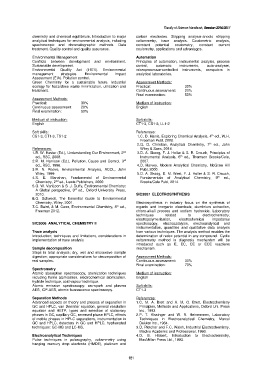Page 187 - handbook 20162017
P. 187
Faculty of Science Handbook, Session 2016/2017
chemistry and chemical equilibrium. Introduction to major carbon electrodes. Stripping analysis-anodic stripping
analytical techniques for environmental analysis, including voltammetry, trace analysis. Coulometric analysis,
spectroscopic and chromatographic methods. Data constant potential coulometry, constant current
treatment. Quality control and quality assurance. coulometry, applications and advantages.
Environmental Management Automation
Conflicts between development and environment. Principles of automation, instrumental analysis, process
Sustainable development. control, automatic instruments, auto-analyser,
Environmental Quality Act (1974). Environmental microprocessor-controlled instruments, computers in
management strategies. Environmental Impact analytical laboratories.
Assessment (EIA). Pollution control.
Green Chemistry for a sustainable future. Industrial Assessment Methods:
ecology for hazardous waste minimization, utilization and Practical: 30%
treatment. Continuous assessment: 20%
Final examination: 50%
Assessment Methods:
Practical: 30% Medium of instruction:
Continuous assessment: 20% English
Final examination: 50%
Medium of instruction: Soft skills:
English CT1-3, CS1-3, LL1-2
Soft skills: References:
th
CS1-3, CT1-3, TS1-2 1.C. D. Harris, Exploring Chemical Analysis, 4 ed., W.H.
Freeman Publ, 2008.
2.G. D. Christian, Analytical Chemistry, 7 th ed., John
References: Wiley & Sons, 2014.
1.R. W. Hester (Ed.), Understanding Our Environment, 2 nd 3.D. A. Skoog, F. J. Holler & S. R. Crouch, Principles of
ed., RSC, 2008. Instrumental Analysis, 6 th ed., Thomson Brooks/Cole,
2.R. M. Harrison (Ed.), Pollution, Cause and Control, 3 rd 2007.
ed., RSC, 1996. 4.D. Harvey, Modern Analytical Chemistry, McGraw Hill
3.R. N. Reeve, Environmental Analysis, ACOL, John Publ, 2000.
Wiley, 1999. 5.D. A. Skoog, D. M. West, F. J. Holler & S. R. Crouch,
4.S. E. Manahan, Fundamental of Environmental Fundamentals of Analytical Chemistry, 9 th ed.,
nd
Chemistry, 2 ed., Lewis Publishers, 2000. Brooks/Cole Publ, 2014.
5.G. W. VanLoon & S .J. Duffy, Environmental Chemistry:
A Global perspective, 3 rd ed., Oxford University Press,
2010. SIC3007 ELECTROSYNTHESIS
6.G. Schwedt, The Essential Guide to Environmental
Chemistry, Wiley, 2001. Electrosynthesis in industry focus on the synthesis of
th
7.C. Baird, & M. Cann, Environmental Chemistry, 5 ed., organic and inorganic chemicals; aluminium extraction,
Freeman 2012. chloro-alkali process and sodium hydroxide. Laboratory
techniques related to electrochemistry;
electropolymerisation, electrochemical impedance
SIC3006 ANALYTICAL CHEMISTRY II spectroscopy, electrocatalysis, electroanalytical and
instrumentation, quantities and qualitative data analysis
Trace analysis from various techniques. The analysis method enables the
Introduction; techniques and limitations, considerations in determination of redox potential in any compound. Cyclic
implementation of trace analysis voltammetry method in diagnosis mechanism will be
introduced such as E, EC, CE or ECE reactions
Sample decomposition mechanism.
Steps in total analysis; dry, wet and microwave sample
digestion; appropriate considerations for decomposition of Assessment Methods:
real samples. Continuous assessment: 30%
Final examination: 70%
Spectrometry
Atomic absorption spectroscopy, atomization techniques Medium of instruction:
including flame atomization, electrochemical atomization, English
hydride technique, cold vapour technique.
Atomic emission spectroscopy: arc-spark and plasma Soft skills:
AES, ICP-AES, atomic fluorescence spectroscopy. CT1-3
Separation Methods References:
Advanced aspects on theory and process of separation in 1.C. M. A. Brett and A. M. O. Brett, Electrochemistry
GC and HPLC, van Deemter equation, general resolution Principles, Methods and Applications, Oxford Uni. Press
equation and HETP, types and selection of stationary Inc., 1993.
phases in GC, capillary GC, reversed phase HPLC, effects 2.P. T. Kissinger and W. R. Heinemmen, Laboratory
of mobile phases in HPLC separations, instrumentation in Techniques in Electroanalytical Chemistry, Marcel
GC and HPLC, detectors in GC and HPLC, hyphenated Dekker Inc., 1984.
techniques: GC-MS and LC-MS. 3.D. Pletcher and F.C. Walsh, Industrial Electrochemistry,
Blackie Academic and Professional, 1993.
Electroanalytical Techniques 4.D. B. Hibbert, Introduction to Electrochemistry,
Pulse techniques in polarography, voltammetry using MacMillan Press Ltd., 1993.
hanging mercury drop electrode (HMDE), platinum and
181

